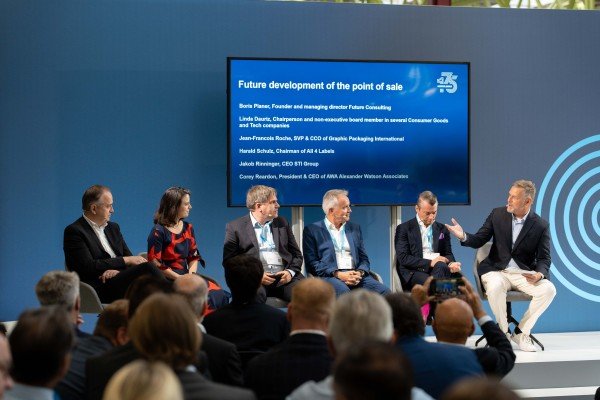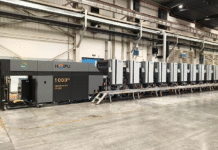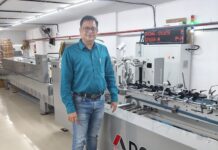
How will the point of sale change in the consumer goods business? What are the challenges associated with the demands of policy makers relating to sustainable packaging? What impact are digitalization and automation having on packaging printing?
As part of the celebrations marking the 175th anniversary of Heidelberger Druckmaschinen AG (Heidelberg), a large and prestigious panel of experts from international packaging companies, industry associations, and the commercial and technology sectors sought answers to these and similar questions in individual presentations and panel discussions. The ‘Packaging Tomorrow’ symposium asked what the future holds for packaging printing.
Changed purchasing behavior and heterogeneous consumer groups
The panelists agreed that there has been no such thing as a typical consumer for quite some time now. The point of sale, too, is feeling the effects of far-reaching economic and societal changes. Society is becoming increasingly heterogeneous. In Europe, for example, there is growing divergence between the needs and purchasing behavior of today’s pensioners and those of Generation Z. The traditional weekly shop is in decline, with people now shopping more often but buying less and often making spontaneous purchases.
The decision whether or not to buy is also increasingly being made spontaneously when standing in front of the shelf. According to the panel of experts, the moment at which the purchasing decision is made is the “moment of truth” – and this truth is increasingly being determined by the design of the packaging. Indeed, the focus is often not on quality or price, but on the emotional pull of the packaging, which is why packaging is becoming an ever more important competitive factor for consumer goods manufacturers. Another reason for its growing significance is the global trend toward consumers being less and less inclined to stick to certain brands and increasingly happy to switch to a different make.
Considerable competitive pressure, impulsive purchasing decisions, and the high level of readiness to make a change all mean that using creative and innovative packaging to attract attention at the point of sale will become ever more important for consumer goods manufacturers. The experts’ message is that the demands on the printing industry are growing along with these challenges. Not only is packaging becoming ever more sophisticated – innovation cycles are also getting ever shorter. The trend toward smaller but more frequent shops is also changing both the volumes being ordered and ordering cycles. Batch sizes are shrinking and timings are getting tighter.
As a result, packaging printers will increasingly need to adapt to even more frequent job changes. One important task when designing packaging will be to draw the young generation in particular back to the physical point of sale in shops. That’s because young people currently make many of their purchases online, where packaging tends to play a less important role in the purchasing decision.
More recycling and reduced CO2 emissions
The amount of packaging coming into circulation worldwide is huge and is worth over 1 trillion US dollars. Most of it is printed, and around a third is made of paper. Studies predict that the value of sustainable packaging will climb to some 520 billion US dollars by 2030. The colossal volume of packaging alone means it has a significant impact on the environment. Folding carton manufacturers that make products for use within the European Union are facing particular challenges in the medium term due to the EU Packaging Directive, which stipulates that all packaging should be recyclable by 2030, thereby cutting CO2 emissions significantly.
The symposium participants agreed that this requirement will offer packaging printers huge opportunities, but also that these businesses cannot meet this challenge alone. Everyone throughout the entire packaging value chain will need to work together on solutions. This not only includes manufacturers of printing substrates such as paper, foils, and films, but also companies making inks, coatings, and adhesives. In addition, at the very start of the process, packaging designers and consumer goods manufacturers themselves also need to get on board. The panelists agreed that tackling such a challenging task alone makes no sense. At the same time, however, everyone involved, including folding carton printers, has an excellent opportunity to win additional orders, while also making a valuable contribution to reducing environmental pollution and achieving the climate goals.
Autonomous packaging printing
The message from the digitalization and automation specialists among the panelists was that data is the key. Whereas folding carton printers used to be typical manual workers, growing automation is now transforming the companies where they work into businesses with largely autonomous operations. In order for these businesses to become “learning organizations” like companies in other sectors, a strong digital data basis is essential. Especially in times when runs are getting shorter, job changes more frequent, and timings and delivery deadlines tighter, this makes reliable planning and optimum processing of print jobs easier.
According to the panel of experts, artificial intelligence tools are opening up whole new dimensions. Digital twins that map products and processes on a 1:1 basis in a digital world are playing a key role in this context. By continuously sharing data, the two worlds are optimizing workflows, predicting potential faults or more serious failures, and thus making packaging printing a whole lot more efficient.
Conclusion – promising potential for folding carton manufacturers
The “Packaging Tomorrow” symposium highlighted the promising business options for folding carton manufacturers as a result of the global trend toward ever more fiber-based packaging and the growing importance of creative packaging at the point of sale. Dr David Schmedding, chief technology & sales officer at Heidelberg, summed it up as follows, “Our ‘Packaging Tomorrow’ symposium has shown that the future of packaging printing is highly automated, autonomous, sustainable, and customized. This opens up huge opportunities for folding carton manufacturers. Companies that invest in creative design, smart automation, and eco-friendly solutions will be among the market winners. Heidelberg is the ideal partner to help its customers achieve this.”










